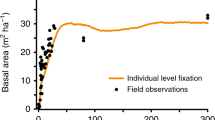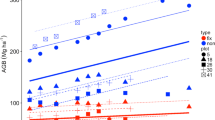Abstract
The future of the land carbon sink depends on the availability of nitrogen (N)1,2 and, specifically, on symbiotic N fixation3,4,5,6,7,8, which can rapidly alleviate N limitation. The temperature response of symbiotic N fixation has been hypothesized to explain the global distribution of N-fixing trees9,10 and is a key part of some terrestrial biosphere models (TBMs)3,7,8, yet there are few data to constrain the temperature response of symbiotic N fixation. Here we show that optimal temperatures for N fixation in four tree symbioses are in the range 29.0–36.9 °C, well above the 25.2 °C optimum currently used by TBMs. The shape of the response to temperature is also markedly different to the function used by TBMs (asymmetric rather than symmetric). We also show that N fixation acclimates to growing temperature (hence its range of optimal temperatures), particularly in our two tropical symbioses. Surprisingly, optimal temperatures were 5.2 °C higher for N fixation than for photosynthesis, suggesting that plant carbon and N gain are decoupled with respect to temperature. These findings may help explain why N-fixing tree abundance is highest where annual maximum temperatures are >35 °C (ref. 10) and why N-fixing symbioses evolved during a warm period in the Earth’s history11,12. Everything else being equal, our findings indicate that climate warming will probably increase N fixation, even in tropical ecosystems, in direct contrast to past projections8.
This is a preview of subscription content, access via your institution
Access options
Access Nature and 54 other Nature Portfolio journals
Get Nature+, our best-value online-access subscription
$29.99 / 30 days
cancel any time
Subscribe to this journal
Receive 12 digital issues and online access to articles
$119.00 per year
only $9.92 per issue
Buy this article
- Purchase on Springer Link
- Instant access to full article PDF
Prices may be subject to local taxes which are calculated during checkout




Similar content being viewed by others
Data availability
Data generated during this study are available on GitHub (https://github.com/tbytnero/Bytnerowicz-Akana-Griffin-Menge-N-fix-Temp; ref. 50).
Code availability
The R code with which data were analysed and figures created is available on GitHub (https://github.com/tbytnero/Bytnerowicz-Akana-Griffin-Menge-N-fix-Temp; ref. 50).
References
Hungate, B. A., Dukes, J. S., Shaw, M. R., Luo, Y. & Field, C. B. Nitrogen and climate change. Science 302, 1512–1513 (2003).
Wieder, W. R., Cleveland, C. C., Smith, W. K. & Todd-Brown, K. Future productivity and carbon storage limited by terrestrial nutrient availability. Nat. Geosci. 8, 441–444 (2015).
Sulman, B. N. et al. Diverse mycorrhizal associations enhance terrestrial C storage in a global model. Glob. Biogeochem. Cycles 33, 501–523 (2019).
Wieder, W. R., Cleveland, C. C., Lawrence, D. M. & Bonan, G. B. Effects of model structural uncertainty on carbon cycle projections: biological nitrogen fixation as a case study. Environ. Res. Lett. 10, 044016 (2015).
Shi, M., Fisher, J. B., Brzostek, E. R. & Phillips, R. P. Carbon cost of plant nitrogen acquisition: global carbon cycle impact from an improved plant nitrogen cycle in the Community Land Model. Glob. Change Biol. 22, 1299–1314 (2016).
Meyerholt, J., Zaehle, S. & Smith, M. J. Variability of projected terrestrial biosphere responses to elevated levels of atmospheric CO2 due to uncertainty in biological nitrogen fixation. Biogeosciences 13, 1491–1518 (2016).
Fisher, J. B. et al. Carbon cost of plant nitrogen acquisition: a mechanistic, globally applicable model of plant nitrogen uptake, retranslocation, and fixation. Glob. Biogeochem. Cycles 24, GB1014 (2010).
Wang, Y. P. & Houlton, B. Z. Nitrogen constraints on terrestrial carbon uptake: Implications for the global carbon-climate feedback. Geophys. Res. Lett. 36, L24403 (2009).
Houlton, B. Z., Wang, Y.-P., Vitousek, P. M. & Field, C. B. A unifying framework for dinitrogen fixation in the terrestrial biosphere. Nature 454, 327–330 (2008).
Steidinger, B. S. et al. Climatic controls of decomposition drive the global biogeography of forest-tree symbioses. Nature 569, 404–408 (2019).
van Velzen, R., Doyle, J. J. & Geurts, R. A resurrected scenario: single gain and massive loss of nitrogen-fixing nodulation. Trends Plant Sci. 24, 49–57 (2018).
Mills, B. et al. Modelling the long-term carbon cycle, atmospheric CO2, and Earth surface temperature from late Neoproterozoic to present day. Gondwana Res. 67, 172–186 (2018).
Fowler, D. et al. The global nitrogen cycle in the twenty-first century. Philos. Trans. R. Soc. B 368, 20130164 (2013).
Rogers, A. et al. A roadmap for improving the representation of photosynthesis in Earth system models. New Phytol. 213, 22–42 (2017).
Prévost, D., Antoun, H. & Bordeleau, L. M. Effects of low temperatures on nitrogenase activity in sainfoin (Onobrychis viciifolia) nodulated by Arctic rhizobia. FEMS Microbiol. Lett. 45, 205–210 (1987).
Rainbird, R. M., Atkins, C. A. & Pate, J. S. Effect of temperature on nitrogenase functioning in cowpea nodules. Plant Physiol. 73, 392–394 (1983).
Dalton, D. A. & Zobel, D. B. Ecological aspects of nitrogen fixation by Purshia tridentata. Plant Soil 48, 57–80 (1977).
Waughman, G. J. The effect of temperature on nitrogenase activity. J. Exp. Bot. 28, 949–960 (1977).
Wheeler, C. T. The causation of the diurnal changes in nitrogen fixation in the nodules of Alnus glutinosa. New Phytol. 70, 487–495 (1971).
Schomberg, H. H. & Weaver, R. W. Nodulation, nitrogen fixation, and early growth of arrowleaf clover in response to root temperature and starter nitrogen. Agron. J. 84, 1046 (1992).
Kou-Giesbrecht, S. & Menge, D. N. L. Nitrogen-fixing trees increase soil nitrous oxide emissions: a meta-analysis. Ecology 102, e03415 (2021).
Bytnerowicz, T. A., Min, E., Griffin, K. L. & Menge, D. N. L. Repeatable, continuous and real‐time estimates of coupled nitrogenase activity and carbon exchange at the whole‐plant scale. Methods Ecol. Evol. 10, 960–970 (2019).
Menge, D. N. L., Lichstein, J. W. & Ángeles-Pérez, G. Nitrogen fixation strategies can explain the latitudinal shift in nitrogen-fixing tree abundance. Ecology 95, 2236–2245 (2014).
Staccone, A. et al. A spatially explicit, empirical estimate of tree-based biological nitrogen fixation in forests of the United States. Glob. Biogeochem. Cycles 32, e2019GB006241 (2020).
Cierjacks, A. et al. Biological flora of the British Isles: Robinia pseudoacacia. J. Ecol. 101, 1623–1640 (2013).
Benson, D. R. & Dawson, J. O. Recent advances in the biogeography and genecology of symbiotic Frankia and its host plants. Physiol. Plant. 130, 318–330 (2007).
Fick, S. E. & Hijmans, R. J. WorldClim 2: new 1-km spatial resolution climate surfaces for global land areas. Int. J. Climatol. 37, 4302–4315 (2017).
Kumarathunge, D. P. et al. Acclimation and adaptation components of the temperature dependence of plant photosynthesis at the global scale. New Phytol. 222, 768–784 (2019).
Heskel, M. A. et al. Convergence in the temperature response of leaf respiration across biomes and plant functional types. Proc. Natl Acad. Sci. USA 113, 3832–3837 (2016).
Kou-Giesbrecht, S. et al. A novel representation of biological nitrogen fixation and competitive dynamics between nitrogen-fixing and non-fixing plants in a land model (GFDL LM4.1-BNF). Biogeosciences 18, 4143–4183 (2021).
Hardy, R. W. F., Holsten, R. D., Jackson, E. K. & Burns, R. C. The acetylene-ethylene assay for N2 fixation: laboratory and field evaluation. Plant Physiol. 43, 1185–1207 (1968).
Cassar, N., Bellenger, J. P., Jackson, R. B., Karr, J. & Barnett, B. A. N2 fixation estimates in real-time by cavity ring-down laser absorption spectroscopy. Oecologia 168, 335–342 (2012).
Taylor, B. N., Chazdon, R. L. & Menge, D. N. L. Successional dynamics of nitrogen fixation and forest growth in regenerating Costa Rican rainforests. Ecology 100, e02637 (2019).
Kok, B. A Critical Consideration of the Quantum Yield of Chlorella-Photosynthesis (W. Junk, 1948).
Liang, L. L. et al. Macromolecular rate theory (MMRT) provides a thermodynamics rationale to underpin the convergent temperature response in plant leaf respiration. Glob. Change Biol. 24, 1538–1547 (2018).
Gunderson, C. A., O’hara, K. H., Campion, C. M., Walker, A. V. & Edwards, N. T. Thermal plasticity of photosynthesis: the role of acclimation in forest responses to a warming climate. Glob. Change Biol. 16, 2272–2286 (2010).
Medlyn, B. E. et al. Temperature response of parameters of a biochemically based model of photosynthesis. II. A review of experimental data. Plant Cell Environ. 25, 1167–1179 (2002).
Slot, M. & Winter, K. In situ temperature relationships of biochemical and stomatal controls of photosynthesis in four lowland tropical tree species. Plant Cell Environ. 40, 3055–3068 (2017).
Murphy, B. K. & Stinziano, J. R. A derivation error that affects carbon balance models exists in the current implementation of the modified Arrhenius function. New Phytol. 6, 2371–2381 (2021).
Yan, W. & Hunt, L. A. An equation for modelling the temperature response of plants using only the cardinal temperatures. Ann. Bot. 84, 607–614 (1999).
Farquhar, G. D. & Busch, F. A. Changes in the chloroplastic CO2 concentration explain much of the observed Kok effect: a model. New Phytol. 214, 570–584 (2017).
Farquhar, G. D., Von Caemmerer, S. & Berry, J. A. A biochemical model of photosynthetic CO2 assimilation in leaves of C3 species. Planta 149, 78–90 (1980).
Duursma, R. A. Plantecophys – an R package for analysing and modelling leaf gas exchange data. PLoS ONE 10, e0143346 (2015).
Bernacchi, C. J., Singsaas, E. L., Pimentel, C., Portis, A. R. Jr & Long, S. P. Improved temperature response functions for models of Rubisco-limited photosynthesis. Plant Cell Environ. 24, 253–260 (2001).
De Kauwe, M. G. et al. A test of the ‘one-point method’ for estimating maximum carboxylation capacity from field-measured, light-saturated photosynthesis. New Phytol. 210, 1130–1144 (2016).
Bolker, B. M. & R. Core Team. bbmle: Tools for General Maximum Likelihood Estimation (R Foundation for Statistical Computing, 2014).
Burnham, K. P. & Anderson, D. R. Multimodel inference: understanding AIC and BIC in model selection. Sociol. Methods Res. 33, 261–304 (2004).
Bolker, B. M. Ecological Models and Data in R (Princeton Univ. Press, 2008).
Venables, W. & Ripley, B. Modern Applied Statistics with S (Springer, 2002).
Bytnerowicz, T. A. tbytnero/Bytnerowicz-Akana-Griffin-Menge-N-fix-Temp: Bytnerowicz_Akana_Griffin_Menge_2022_Nature_Plants https://doi.org/10.5281/zenodo.5764790 (2021).
Acknowledgements
We thank D. Tufts for assistance with the culture and preservation of bacteria, and the numerous friends at Columbia’s E3B department and Lamont-Doherty Earth Observatory who watered and fertilized plants. This publication was developed under STAR Fellowship Assistance Agreement no. FP91781501–0 awarded by the US Environmental Protection Agency (EPA) to T.A.B. Support was given by the Stengl-Wyer Scholars Program awarded by the University of Texas at Austin to T.A.B., by the National Science Foundation (NSF) Graduate Research Fellowship Program (no. DGE-2036197) to P.R.A. and by an NSF grant (no. DEB‐1457650) to D.N.L.M. This publication has not been formally reviewed by EPA. The views expressed in this publication are solely those of the authors, and EPA does not endorse any products or commercial services mentioned herein.
Author information
Authors and Affiliations
Contributions
T.A.B., K.L.G. and D.N.L.M. conceived of the project. T.A.B. and P.R.A. collected data. T.A.B. conducted analyses and wrote the initial draft. All authors contributed to writing.
Corresponding author
Ethics declarations
Competing interests
The authors declare no competing interests.
Peer review
Peer review information
Nature Plants thanks Yingping Wang and the other, anonymous, reviewers for their contribution to the peer review of this work.
Additional information
Publisher’s note Springer Nature remains neutral with regard to jurisdictional claims in published maps and institutional affiliations.
Supplementary information
Supplementary Information
Supplementary text, Tables 1–14 and Figs. 1–17.
Rights and permissions
About this article
Cite this article
Bytnerowicz, T.A., Akana, P.R., Griffin, K.L. et al. Temperature sensitivity of woody nitrogen fixation across species and growing temperatures. Nat. Plants 8, 209–216 (2022). https://doi.org/10.1038/s41477-021-01090-x
Received:
Accepted:
Published:
Issue Date:
DOI: https://doi.org/10.1038/s41477-021-01090-x
This article is cited by
-
Climate tipping point of nitrogen fixation
Nature Plants (2022)



